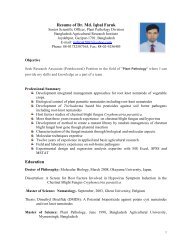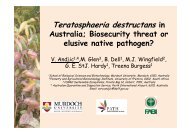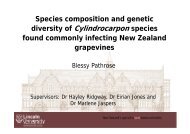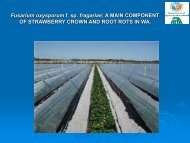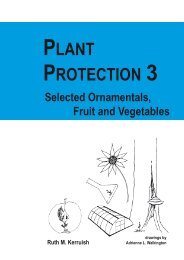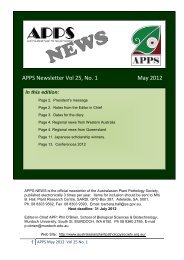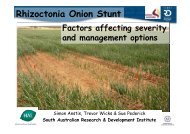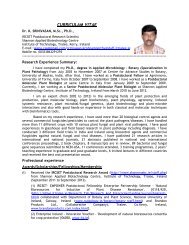POSTHARVEST DISEASES OF FRUIT AND VEGETABLES Lindy ...
POSTHARVEST DISEASES OF FRUIT AND VEGETABLES Lindy ...
POSTHARVEST DISEASES OF FRUIT AND VEGETABLES Lindy ...
You also want an ePaper? Increase the reach of your titles
YUMPU automatically turns print PDFs into web optimized ePapers that Google loves.
33<br />
<strong>POSTHARVEST</strong> <strong>DISEASES</strong> <strong>OF</strong> <strong>FRUIT</strong> <strong>AND</strong> <strong>VEGETABLES</strong><br />
Contents<br />
<strong>Lindy</strong> Coates and Greg Johnson<br />
33.7 Introduction ....,... 533<br />
33.2 Causes of postharuest disease ............ 534<br />
33.3 Host phgsioLogicat status ..... 538<br />
33.4 Mode of iryfection........... ..... 539<br />
33.5 TraditionaL strategtesJor postharuest disease controL and<br />
preuention .... 541<br />
F\trgicides ....... 541<br />
Maintenance oJ host resistance to tnfection through<br />
mantpuLation oJ ttrc po stharue st enuironment ............... 542<br />
Hggiene practtces ............. 543<br />
PreharuestJactors ............. 544<br />
Preuention oJ tr$ury... ............ 544<br />
Heat treatments ........,.....,. 544<br />
Ionising radiation.. ............... 545<br />
33. 6 Emerging technoLogie s Jor po stharue st disease controL........ 545<br />
BiaLogical controL ,.............. 545<br />
Constttttttue and indtrced host resistan ce .........................<br />
546<br />
NaturaLfungicides ............ 546<br />
33.7 Conclusions ....,.., 547<br />
33.8 F\trther readtng ... 547<br />
33.1 Introduction<br />
Losses due to postharvest disease may occur at any time during postharvest<br />
handling, from harvest to consumption. When estimating postharvest disease<br />
losses, it is important to consider reductions in fruit quantity and quality, as<br />
some diseases may not render produce unsaleable yet still reduce product value.<br />
For example, blemished fruit may not be sold as fresh fruit but may still be<br />
suitable for processing, in which case, it brings a lower price. It is also important<br />
to take into account costs such as harvesting, packaging and transport when<br />
determining the value of produce lost as a result of postharvest wastage.<br />
Aside from direct economic considerations, diseased produce poses a potential<br />
health risk. A number of fungal genera such as PentcttLium, ALternarta and<br />
FLsarium are known to produce mycotoxins under certain conditions. Generally<br />
speaking, the greatest risk of mycotoxin contamination occurs when diseased<br />
produce is used in the production of processed food or animal feed. In most<br />
cases, fresh produce which is obviously diseased would not be consumed.<br />
Losses due to postharvest disease are affected by a great number of factors<br />
including:<br />
. commodity type<br />
o cultivar susceptibility to postharvest disease
534 Lindg Coates and Greg Johnson<br />
o the postharvest environment (temperature, relative humidity, atmosphere<br />
composition, etc.)<br />
. produce maturity and ripeness stage<br />
o treatments used for disease control<br />
. produce handling methods<br />
o postharvest hygiene.<br />
These factors will be discussed in detail later in this chapter.<br />
Virtually all postharvest diseases of fruit and vegetables are caused by fungi<br />
and bacteria. In some root crops and brassicas, viral infections present before<br />
harvest can sometimes develop more rapidly after harvest. In general, however,<br />
viruses are not an important cause of postharvest disease.<br />
Postharvest diseases are often classified according to how infection is initiated.<br />
The so-called 'quiescent' or 'latent' infections are those where the pathogen<br />
initiates infection of the host at some point in time (usually before harvest), but<br />
then enters a period of inactivity or dormancy until the physiological status of the<br />
host tissue changes in such a way that infection can proceed. The dramatic<br />
physiological changes which occur during fruit ripening are often the trigger for<br />
reactivation of quiescent infections. Examples of postharvest diseases arising<br />
from quiescent infections include anthracnose of various tropical fruit caused by<br />
CoLletotrichum spp. and grey mould of strawberryr caused by Botrytis cinerea.<br />
The other major group of postharvest diseases are those which arise from<br />
infections initiated during and after harvest. Often these infections occur through<br />
surface wounds created by mechanical or insect injury. Wounds need not be<br />
large for infection to take place and in many cases may be microscopic in size.<br />
Common postharvest diseases resulting from wound infections include blue and<br />
green mould (caused by PenicitLium spp.) and transit rot (caused by Rhlzopus<br />
stoLonifer). Bacteria such as -Drutnia carotouora (soft rot) are also common wound<br />
invaders. Many pathogens, such as the banana crown rot fungi, also gain entry<br />
through the injury created by severing the crop from the plant.<br />
33.2 Causes of postharvest disease<br />
Correct identification of the pathogen causing postharvest disease is central to<br />
the selection of an appropriate disease control strategy. Table 33.1 lists some<br />
common postharvest diseases and pathogens of fruit and vegetables.<br />
Many of the fungi which cause postharvest disease belong to the phylum<br />
Ascomycota and the associated Fungi Anamorphici (Fungi Imperfecti). In the case<br />
of the Ascomycota, the asexual stage of fungus (the anamorph) is usually<br />
encountered more frequently in postharvest diseases than the sexual stage of the<br />
fungus (the teleomorph). Important genera of anamorphic postharvest pathogens<br />
include PenicitLtum, Aspergitlus, Geotrichum, Botrgtis, Fusarium, ALternqri-a,<br />
CoLletotrtchum, DothtoreLLa, Lastodiplodiaand Phomopsis. Some of these fungi also<br />
form ascomycete sexual stages.<br />
In the phylum Oomycota, the genera Phgtophthora and Pgtttium are important<br />
postharvest pathogens, causing a number of diseases such as brown rot in citrus<br />
(Phgtophthora citrophthora and P. parasitica) and cottony leak of cucurbits<br />
(Pgthium spp.). Rhizopus and Mucor are important genera of postharvest<br />
pathogens in the phylum Zygornycota. R. stoLonif,er is a common wound pathogen<br />
of a very wide range of fruit and vegetables, causing a rapidly spreading watery<br />
soft rot. Genera within the phylum Basidiomycota are generally not important<br />
causal agents of postharvest disease, although fungi such as Sclerotium rolfsiiand<br />
Rhizoctonia solanr, which have basidiomycete sexual stages, can cause<br />
significant postharvest losses of vegetable crops such as tomato and potato.
33. Postharuest diseases oJJrutt and uegetables 535<br />
While diseases caused by these pathogens are primarily field diseases, the<br />
development of symptoms often accelerates after harvest.<br />
The major causal agents of bacterial soft rots are various species of Ertuinia,<br />
Pseudomonas, Bacittus, LactobaciLLus and Xanthomonas. Bacterial soft rots are<br />
very important postharvest diseases of many vegetables, although they are<br />
generally of less importance in most fruit. This is because most fruit have a low<br />
pH which is inhibitory to the majority of bacterial plant pathogens.<br />
Table 33.1<br />
Examples of common postharvest diseases and pathogens of fruit and vegetables.<br />
Disease<br />
Anamorph<br />
Pathogen<br />
Teleomorph<br />
TemperoteJruit<br />
Pome Ftuit<br />
Blue mould<br />
Pemcillium spp.<br />
Grey mould Botrytis ctnerea BotryotiniaJrrckeltana<br />
Bitter rot Colletotrtchum Glomerella cingulata<br />
gloeosporioides<br />
Alternaria rot Alternaria spp.<br />
Mucor rot<br />
Mucor pirif,ormts<br />
Stone Fruit<br />
Brown rot Monrfto spp. Moniliniafiuctrrcola (syn.<br />
SclerotintaJrtrcticola)<br />
Rhizopus rot Rhizopus spp.(mostly R.<br />
stolonde)<br />
Grey mould Botrytis ctnerea BotryotiniaJtrckeltana<br />
Blue mould<br />
Penicrllium spp.<br />
Alternaria rot<br />
Alternaria alternata<br />
Grapes<br />
Grey mould Botrgtis ctnerea Botryotiniafuckeltana<br />
Blue mould<br />
Penrrctllium spp.<br />
Rhizopus rot<br />
Rhrzopus spp.<br />
BeIries<br />
Grey mould Botrgtis cinerea BotryotiniaJuckellana<br />
Rhizopus rot<br />
Rhrzopus spp.<br />
Cladosporium rot Cladosportum spp.<br />
Blue mould<br />
Penrcrllium spp.<br />
SubtropicatJruit<br />
Citrus Fruit<br />
Blue mould<br />
Penictlltum ttalicum<br />
Green mould<br />
Penicillium digttatum<br />
Black centre rot ALternarta citrt<br />
Stem end rot Phomopsis citrt Diaporthe citrt<br />
Brown rot<br />
Phgtophthora citrophilnra<br />
and/or P. parasitica
536<br />
Lindg Coates and Greg Johnson<br />
Table 33.1 (continued)<br />
Disease<br />
Anamorph<br />
Pathogen<br />
Teleomorph<br />
Avocado<br />
Anthracnose<br />
Stem end rot<br />
TropicalJruit<br />
Bacterial soft rot<br />
Cotletotrichum<br />
gloeosportoid.es<br />
C. acutatum<br />
Dothi.oreLla spp.<br />
La.s io dtplodia the obr omae<br />
Sttlbella cinnabarina<br />
Phomopsis perseae<br />
Ertuinta carotouora<br />
GlomerelLa cingulata<br />
Botryosphaena spp.<br />
Thgronectrta pseudotrtchia<br />
Banana<br />
Anthracnose<br />
Colletotrtchlrm musae<br />
Crown rot<br />
Various fungi including<br />
R"rsanum spp.,<br />
VerttciLlium spp.,<br />
Acremontum sp. and<br />
Colletotrichum mLrsae<br />
Black end<br />
Various fungi including<br />
C olletotrtchum mrrs ae,<br />
Nigrospora sphaertca<br />
and Fi.rsanum spp.<br />
Ceratocystisfruitrot Thtelautopsisparadoxa Ceratocgstis paradoxa<br />
Mango<br />
Anthracnose Colletotrtchum Glomerelta ctngulata<br />
gloeosporioides<br />
C. acutatum<br />
Stem end rot Dothiarella spp. Botrgosphaena spp.<br />
Las io diplo dia the obr omae<br />
Phomopsus mangif,erae<br />
P e s talotiop s is mang if,e r ae<br />
Rhizopus rot<br />
Rhizopus stolonif,er<br />
Black mould<br />
Aspergilhs niger<br />
Alternaria rot Alternarta alternata<br />
Grey mould Botrytis ctnerea Botryottntaftrckeltana<br />
Blue mould<br />
Penicilliumexpansum<br />
Mucor rot<br />
Mucor circtnelloides<br />
Pawpaw (Papaya)<br />
Anthracnose<br />
ColLetotrtchum spp.<br />
Black rot Phoma cartcae-papagae Mgcosphaerelta cartcae<br />
Phomopsis rot Phomopsis caricae-papagae<br />
Rhizopus rot<br />
Rhizoptts stoloni-Jer<br />
Phytophthora fruit rot<br />
Phgtophtltora palmiuora<br />
Pineapple<br />
Water blister ThieLautopsis paradoxa Ceratocgstis paradoxa
33. Postharuest diseases oJJrttit and uegetables<br />
537<br />
Table 33.1 (continued)<br />
Disease<br />
Fruitlet core rot<br />
Yeasty rot<br />
Bacterial brown rot<br />
Pathogen<br />
Anamorph<br />
Teleomorph<br />
PentcilliumJuntculosum<br />
F\sarlum monildorme var GibberetlaJ4jikuroi var<br />
subglutinans<br />
subatuinans<br />
Saccharomgces spp.<br />
Ertuinia oirToinas<br />
Vegetables<br />
Cucurbits<br />
Bacterial soft rots Various Eru-rtnia spp.,<br />
Bactlkts polgmgxa,<br />
P s e ttdomonas sg ring ae,<br />
Xanthomonas campesfis<br />
Grey mould Botrgtis cinerea BotryottniaJrrckeLiana<br />
Fusarium rot<br />
Filsanum spp.<br />
Alternaria rot Alternaria spp.<br />
Charcoal rot<br />
Macroplrcmina phaseoltna<br />
Cottony leak<br />
iythrum spp.<br />
Rhizopus rot<br />
Rhrzopus spp.<br />
Tomato, Eggplant And Capslcum<br />
Bacterial soft rots Various Enurnia spp.,<br />
Bacillrts polgmgxa,<br />
Pseudomonas spp. and<br />
Xanthomona,s camp e stris<br />
Grey mould Botrytis cinerea Botryottntafuckeliana<br />
Fusarium rot<br />
Ftrsanum spp.<br />
Alternaria rot Alternaria alternata<br />
Cladosporium rot Ctadosporium spp.<br />
Rhizopus rot<br />
Rhrzopus spp.<br />
Watery soft rot<br />
Sclerotinia spp.<br />
Cottony leak<br />
Pyfhium spp.<br />
Sclerotium rot Sclerotium rol"Jsii (sclerotial Athelia rolJsti<br />
statel<br />
Legumes<br />
Grey mould Botrytis ctrterea BotryottntaJuckeltana<br />
B.Jabae<br />
White mould and<br />
Watery soft rot<br />
Sclerotrnia spp.<br />
Cottony leak<br />
lyfhium spp.<br />
Sclerotium rot Sclerotium ro(/sri (sclerotial Athelin rolfstt<br />
state)<br />
Brassicas<br />
Bacterial soft rot Various Erurinra spp.<br />
Bactllus spp.<br />
Pseudomonas spp. and<br />
Xanthomonas campesfis<br />
Grey mould Botrytis cirterea Botryotintajrckeliana<br />
Alternaria rot Altemarta spp.
538<br />
Ltndg Coates and Greg Johnson<br />
Table 33.1 (continued)<br />
Disease<br />
Pathogen<br />
Anamorph<br />
Teleomorph<br />
Watery soft rot<br />
Phytophthora rot<br />
Leafy Vegetables<br />
Bacterial soft rot<br />
Grey mould<br />
Watery soft rot<br />
Onions<br />
Bacterial soft rot<br />
Black mould rot<br />
Fusarium basal rot<br />
Smudge<br />
Carrots<br />
Bacterial soft rot<br />
Rhizopus rot<br />
Grey mould<br />
Watery soft rot<br />
Sclerotium rot<br />
Chalara and<br />
Thielaviopsis rots<br />
Potatoes<br />
Bacterial soft rot<br />
Dry rot<br />
Gangrene<br />
Black scurf<br />
Silver scurf<br />
Skin spot<br />
Various Eruinia spp.<br />
Pseu.domonas spp. and<br />
Xantho monas campes trrs<br />
Botrytis cinerea<br />
Various Eruinia spp.<br />
LactobaciLltts spp. and<br />
Pseu.domonas spp.<br />
Aspergillus niger<br />
Flts arium orqsporum f. sp.<br />
cepae<br />
C olle totrtchum cir cinans<br />
Various Ertuinia spp. and<br />
Pseudomonas spp.<br />
Botrgtis ctnerea<br />
S cler otium r otJs ii ( s c lero tia-l<br />
state)<br />
Chal.ar a thietauioid-e s<br />
Thielautop s is b asicola<br />
Erurnia spp.<br />
FLsanum spp.<br />
Phoma exiguavar exigua<br />
andvar Joueata<br />
Rhizoctonta solani.<br />
(sclerotial state)<br />
H elmtntho s p ortum solani<br />
P olg s cg talum pus tulans<br />
Sclerotrnra spp.<br />
Phgtopttthora porri<br />
BotryotintaJtrckeltana<br />
Scterofinra spp.<br />
Rhrzoplrs spp.<br />
BotryottntaJuckeliana<br />
Sclerohnia spp.<br />
Athelin rolfsii<br />
Gibberella spp.<br />
Thanatephorus cucumerb<br />
33.3 Host physiological status<br />
The development of postharvest disease is intimately associated with the<br />
physiological status of the host tissue. To create the right environment for<br />
minimising postharvest losses due to disease it is important to understand the<br />
physiological changes that occur after produce is harvested.<br />
All plant organs undergo the physiological processes of growth, development<br />
and senescence. Growth and development generally only occur while the organ is<br />
attached to the plant (with the exception of seed germination and sprouting of<br />
storage organs), but senescence will occur regardless of whether the organ is
33. Postharuest diseases oJJruit and uegetables 539<br />
attached or not (albeit at different rates). When an organ such as a fruit is<br />
harvested from a plant, it continues to respire and transpire depleting both food<br />
reserves and water. Such changes ultimately lead to senescence. Treatments<br />
which slow respiration and water loss, such as cool storage, therefore help to<br />
delay senescence. Different commodity types vary greatly in the processes which<br />
precede senescence, making it difficult to draw general conclusions. For this<br />
reason, the following discussion will be limited to fruit.<br />
'Maturity' is a term often used in reference to fruit and is frequently confused<br />
with the term 'ripeness'. Put simply, physiological maturity is attained when the<br />
process of natural growth and development is complete. In practice, fruit are<br />
considered to be mature when they have reached a stage where, after harvesting<br />
and postharvest handling, they will ripen to an acceptable quality. In contrast, a<br />
ripe fruit is one which is ready to eat. The process of ripening basically signals<br />
the end of development and the beginning of senescence. It can involve a number<br />
of changes in the fruit, such as conversion of starch to sugars, increase in pH,<br />
increase in fruit softness, development of aromas, reduction in chlorophyll<br />
content and corresponding increase in carotenoid levels (yellow and orange<br />
pigments).<br />
Fruit are often classified into two groups on the basis of how they ripen<br />
(Table 33.2). Climacteric fruit exhibit a pronounced increase in respiration and<br />
ethylene production coincidentally with ripening. Climacteric fruit can be<br />
harvested in an unripe state and providing they are sufficiently mature, will ripen<br />
to an acceptable quality. Non-climacteric fruit do not exhibit a rapid increase in<br />
respiration during the ripening process. The eatlng quality of non-climacteric fruit<br />
does not improve after harvest, although they may undergo some changes in<br />
colour development and softening. For this reason they should not be harvested<br />
until they are ready to eat.<br />
33.4 Mode of infection<br />
Infection of fruit and vegetables by postharvest pathogens can occur before,<br />
during or after harvest. Infections which occur before harvest and then remain<br />
quiescent until some point during ripening are particularly common amongst<br />
tropical fruit crops. Anthracnose, which is the most serious postharvest disease<br />
of a wide range of tropical and sub-tropical fruit such as mango, banana, pawpaw<br />
(papaya) and avocado, is an example of a disease arising from quiescent<br />
infections established prior to harvest. Anthracnose is also an important<br />
postharvest disease of a number of vegetables (e.g. bean) and temperate fruit (e.g.<br />
strawberry). Various species of CoLtetotrichum can cause anthracnose. Some<br />
species (e.9. C. mtrsote) are host-specific, whereas others can attack a wide range<br />
of fruit and vegetables (e.€. C. gLoeosporioides). The infection process begins when<br />
conidia germinate on the surface of host tissue to produce a germ tube and an<br />
appressorium. Although it is known that there is a quiescent phase in the life<br />
cycle of the fungus, it is not entirely clear whether the ungerminated or the<br />
germinated appressorium represents the quiescent stage, as different studies<br />
have reported conflicting results. It may be that the fungus behaves differently on<br />
different hosts, or perhaps some researchers have been unable to detect<br />
appressorial germination due to the limitations of the techniques used. In<br />
avocado for example, early studies reported that ungerminated appressoria were<br />
the quiescent phase of C. gLoeosporioides. Studies conducted two decades later<br />
however showed that appressoria germinated to produce infection hyphae prior to<br />
the onset of quiescence. In any case, the fungus ceases growth soon after<br />
appressorium formation and remains in a quiescent state until fruit ripening
540<br />
occurs. During ripening, the fungus resumes activity and colonises the fruit<br />
tissue, leading to the development of typical anthracnose symptoms.<br />
Table 33.2<br />
Classification of some common edible fruit according to respiratory behaviour<br />
during ripening.<br />
Climacteric fruit<br />
apple<br />
apricot<br />
avocado<br />
banana<br />
blueberry<br />
custard apple<br />
guava<br />
kiwi fruit<br />
mango<br />
melon<br />
nectarine<br />
pawpaw (papaya)<br />
passionfruit<br />
peach<br />
pear<br />
persimmon<br />
plum<br />
tomato<br />
Non-climacteric fruit<br />
blackberry<br />
carambola<br />
cherry<br />
cucumber<br />
eggplant<br />
grape<br />
grapefruit<br />
lemon<br />
lime<br />
longan<br />
lychee<br />
mandarin<br />
orange<br />
peas<br />
pineapple<br />
raspberry<br />
strawber4r<br />
watermelon<br />
Natural antifungal compounds present in fruit tissue may be involved in<br />
regulating the quiescence of CoLletotrtchum infections. In avocados, antifungal<br />
dienes are present in the peel of unripe fruit at concentrations inhibitory to<br />
CoLtetotrichum gLoeosporioides, the avocado anthracnose pathogen. During<br />
ripening, levels of these dienes decline to sub-fungitoxic levels coincidentally with<br />
the development of anthracnose symptoms on fruit. Treatments which stimulate<br />
the production of diene compounds also delay symptom development, suggesting<br />
that these compounds have a role in regulating quiescence.<br />
Grey mould of strawberry caused by Botrgtis cinerea is another important<br />
postharvest disease sometimes arising from quiescent infections established<br />
before harvest. Conidia of B. cinerea on the surface of necrotic flower parts<br />
germinate in the presence of moisture. The fungus colonises the necrotic tissue<br />
and then remains quiescent in the base of the floral receptacle. Several months<br />
later when fruit are harvested, infections develop as a stem end rot in ripe fmit.<br />
Many postharvest diseases develop from the stem end of fruit. The mode of<br />
infection involved in this group of diseases can however vary considerably. In the<br />
example of B. cinerea, lesions occurring at the stem end of fruit arise from<br />
quiescent floral infections. Stem end rots of citrus caused by Lasiodiplodta<br />
theobromae and Phomopsis citri result from quiescent infections in the stem<br />
button of fruit. These infections can be initiated at any stage of fruit development,<br />
and remain quiescent until the button begins to separate from the fruit during<br />
abscission. In other stem end rot diseases, infection occurs during and after<br />
harvest through the wound created by severing the fruit from the plant (e.g.<br />
banana crown rot). Recent studies have brought attention to another important<br />
mode of infection involved in the development of some stem end rot diseases.<br />
Endophytic infection, whereby the fungus symptomlessly and systemically<br />
colonises the stem, inflorescence and fruit pedicel tissue, is important in a<br />
number of stem end rot diseases of tropical fruit. Mango stem end rot caused by<br />
Dothtorella domintcana is one example of a postharvest disease arising from
33. Postharuest diseases oJJrutt and uegetables 541<br />
endophytic colonisation of fruit pedicel tissue. In this case, the fungus colonises<br />
the pedicel and stem end tissue of unripe fruit, where it remains quiescent until<br />
fruit ripening commences.<br />
A considerable number of postharvest diseases develop from infections which<br />
occur shortly before harvest. Such infections may not be visible at the time of<br />
harvest, yet at the same time are not necessarily inactive. Symptoms may develop<br />
more rapidly after harvest, particularly if storage conditions favour pathogen<br />
development. Examples of postharvest diseases which can arise from late season<br />
infections include brown rot of peach (caused by MontltntaJrtrcttcola), grey mould<br />
of grape (caused by Botrytis cinerea), yeasty rot of tomato (caused by Geotrichum<br />
crrndidum) and sclerotium rot of various vegetables (caused by Sclerotiumrolfsit).<br />
Many common postharvest pathogens are unable to directly penetrate the host<br />
cuticle. Such pathogens therefore infect through surface injuries or natural<br />
openings such as stomata and lenticels. Injuries can vary in size from<br />
microscopic to clearly visible and may arise in a number of ways. Mechanical<br />
injuries such as cuts, abrasions, pressure damage and impact damage commonly<br />
occur during harvesting and handling. Insect injuries may occur before harvest<br />
yet remain undetected at the time of grading, providing ideal infection sites for<br />
many postharvest pathogens. Infection of lychee fruit by yeasts commonly occurs<br />
through insect injuries which are difficult to see at harvest. Some chemical<br />
treatments used after harvest, such as fumigants used in insect disinfestation<br />
and disinfectants such as chlorine, may also injure produce if applied incorrectly.<br />
Various types of physiological injury such as chilling and heat injury can<br />
predispose produce to infection by postharvest pathogens. Tropical fruit in<br />
particular are very sensitive to low temperatures, many developing symptoms of<br />
chilling injury below l3'C (depending on storage duration). Symptoms of chilling<br />
injury include abnormal ripening, peel and flesh discolouration, water-soaking<br />
and pitting. Chilling injury can increase the susceptibility of produce to<br />
postharvest disease considerably. For example, the incidence of alternaria rot in<br />
pawpaw, apple and various vegetable crops is increased by exposure to excessive<br />
cold. High temperatures can also increase susceptibility of harvested produce to<br />
disease. For example, hot water dipping of mangoes for excessive times and/or<br />
temperatures can result in increased levels of stem end rot (caused by DothioretLa<br />
spp.).<br />
The natural resistance of fruit and vegetables to disease declines with storage<br />
duration and ripeness. Weak pathogens which normally require a wound in order<br />
to infect can become a problem in produce that has been stored for long periods<br />
of time. Treatments which help to maintain the natural<br />
'vitality' of fruit and<br />
vegetables aid in delaying the onset of disease in stored produce.<br />
33.5 Traditional strategies for postharvest disease control and prevention<br />
Fungicides<br />
Fungicides are used extensively for postharvest disease control in fruit and<br />
vegetables. Timing of application and type of fungicide used depend primarily on<br />
the target pathogen and when infection occurs. For postharvest pathogens which<br />
infect produce before harvest, field application of fungicides is often necessary.<br />
This may involve the repeated application of protectant fungicides during the<br />
growing season, and/or strategic application of systemic fungicides. In the<br />
control of mango anthracnose (caused by CoLLetotrichum gLoeosporioides) in<br />
Australia, for example, trees are sprayed regularly with a protectant fungicide<br />
such as mancozeb during flowering and fruit development. If rain occurs during
542<br />
flowering, a systemic fungicide is applied to inactivate infections already<br />
established and to guard against new infections.<br />
In the postharvest situation, fungicides are often applied to control infections<br />
already established in the surface tissues of produce or to protect against<br />
infections which may occur during storage and handling. In the case of quiescent<br />
field infections present at the time of harvest, fungicides must be able to<br />
penetrate to the site of infection to be effective. Systemic fungicides are generally<br />
used for this purpose, although how deeply they penetrate when applied in this<br />
way is not well documented. In some tropical fruit crops such as mango, the<br />
penetration of systemic fungicides is enhanced by applying them as heated dips.<br />
In the case of infections which occur during and after harvest, fungicides can<br />
be used to interrupt pathogen development. How successful fungicides are in<br />
doing this depends largely on the extent to which infection has developed at the<br />
time of fungicide application and how effectively the fungicide penetrates the host<br />
tissue. In general, fungicides for the control of wound-invading pathogens should<br />
be applied as soon as possible after harvest. If infection is well advanced at the<br />
time of postharvest treatment, control will be difficult to achieve. The usual<br />
approach with controlling wound pathogens is to maintain a certain<br />
concentration of the fungicide at the injury site which will suppress (though not<br />
necessarily kill) pathogen development until the wound has healed. In this sense,<br />
most of the 'fungicides' which are used postharvest are actually fungistatic rather<br />
than fungicidal in their action under normal usage. Disinfectants such as sodium<br />
hypochlorite can be used to kill pathogen propagules on the surface of fruit, but<br />
are unable to control pathogens once they have gained entry to host tissue.<br />
Postharvest fungicides can be applied as dips, sprays, fumigants, treated<br />
wraps and box liners or in waxes and coatings. Dips and sprays are very<br />
commonly used and depending on the compound, can take the form of aqueous<br />
solutions, suspensions or emulsions. Fungicides commonly applied as dips or<br />
sprays include the benzimidazoles (e.g. benomyl and thiabendazole) and the<br />
triazoles (e.g. prochloraz and imazalil). The benzimidazole group of fungicides are<br />
very useful for the control of many important postharvest pathogens such as<br />
PeniciLLium and CoLLetotrichum^ Fumigants, such as sulphur dioxide for the control<br />
of grey mould (caused by Botrgtis cinerea-) of grape and various postharvest<br />
diseases of lychee, are sometimes used for disease control. Other fumigants used<br />
in certain situations include carbon dioxide, ozone and ammonia. Fruit wraps or<br />
box liners impregnated with the fungicide biphenyl are used in some countries for<br />
the control of PeniciLLtum in citrus. Fungicides to control postharvest diseases of<br />
citrus and some other fruit are often applied to the fruit in wax on the packing<br />
Iine.<br />
Maintenance of hosf resistance to infection through manipulation of the postharvest<br />
environment<br />
The ability to control the postharvest environment provides a tremendous<br />
opportunity to delay senescence. Temperature is perhaps the single most<br />
important factor influencing disease development after harvest. Temperature not<br />
only directly influences the rate of pathogen growth, but also the rate of fruit<br />
ripening. The development of many postharvest diseases is closely associated<br />
with fruit ripeness, so treatments which delay ripening tend also to delay disease<br />
development. Low temperature storage of fruit and vegetables is used extensively<br />
to delay ripening and the development of disease, although the temperatures<br />
commonly used for storage are not lethal to the pathogen. For this reason, coolstored<br />
produce which is transferred to ambient temperatures for ripening and/or
33. Postharuest dtseases oJJrutt and uegetables 543<br />
sale may rapidly breakdown with postharvest disease. Temperatures used to<br />
store produce depend largely on the chilling sensitivity of the produce in<br />
question. For example, many temperate fruit and vegetables (e.g. apples, peaches<br />
and broccoli) can be stored at OoC, whereas many tropical fruits cannot be stored<br />
below lO"C without developing symptoms of chilling injury.<br />
Modifying the storage atmosphere is sometimes used to delay produce<br />
senescence. The rate of fruit respiration can be reduced by increasing CO2 and<br />
decreasing 02 levels in the storage environment. Storage atmosphere can also<br />
have a direct effect on pathogen growth, although levels of CO, or 02 required to<br />
achieve this are often damaging to the produce if applied for extended periods. A<br />
notable exception to this is strawberry, which for extended storage periods can<br />
tolerate the high levels of CO2 (2O-3Oo/o) required to inhibit the development of<br />
grey mould (caused by Botrytis cinerea). Short-term exposure to very high levels<br />
of CO2 has shown some potential for delaying the onset of anthracnose (caused<br />
by CoLLetotrichum gtoeosportotdes) symptoms in avocado, although the treatment<br />
is not currently in commercial use.<br />
The relative humidity of the storage environment can have a major influence<br />
on the development of postharvest disease. High humidities are often used to<br />
minimise water loss of produce. This however can increase disease levels,<br />
particularly if free moisture accumulates in storage containers. The humidity<br />
chosen for storing produce is frequently a 'trade-off between minimising water<br />
loss and minimisinq disease.<br />
Hygiene practices<br />
Maintenance of hygiene at all stages during production and postharvest handling<br />
is critical in minimising sources of inoculum for postharvest diseases. To most<br />
effectively reduce inoculum, a good knowledge of the life cycle of the pathogen is<br />
essential. Sources of inoculum for postharvest diseases depend largely on the<br />
pathogen and when infection occurs. In the case of postharvest diseases which<br />
arise from preharvest infections, practices which make the crop environment less<br />
favourable to pathogens will help reduce the amount of infection which occurs<br />
during the growing season. For example in tree crops, pruning and skirting can<br />
increase ventilation within the tree canopy, making conditions less favourable for<br />
fungi and bacteria. Removal of dead branches and leaves entangled in the tree<br />
canopy is also an important way to minimise inoculum build-up. In many<br />
diseases, overhead irrigation can encourage pathogen spread and infection,<br />
trickle or micro-sprinkler irrigation systems may be more appropriate. As many<br />
pathogens are soil-borne, minimising contact of leaves and fruit with the soil is<br />
desirable.<br />
Inoculum for infections occurring after harvest commonly originates from the<br />
packing shed and storage environments.<br />
o Water used for washing or cooling produce can become contaminated with<br />
pathogen propagules if not changed on a regular basis and if a disinfectant<br />
such as chlorine is not incorporated. Water temperature can also be an<br />
important factor in the transfer of inoculum in some situations. For example,<br />
tomatoes harvested during hot weather may have a higher temperature than<br />
the water used to wash them. In this scenario, inoculum present in the<br />
washing water can be taken in by the fruit tissue, causing higher levels of<br />
diseases such as bacterial soft rot.<br />
o Reject produce which has not been discarded from the packing shed or storage<br />
environment provides an ideal substrate for postharvest pathogens.
544<br />
Packing and grading equipment, particularly brushes and rollers, which is not<br />
cleaned and disinfected on a regular basis can also be a major source of<br />
inoculum.<br />
Containers used for storing and transporting fruit can harbour pathogen<br />
propagules, particularly if recycled a number of times without proper cleaning.<br />
Preharvest tactors<br />
A wide range of preharvest factors influence the development of postharvest<br />
disease. These include the weather (rainfall, temperature, etc.), production<br />
locality, choice of cultivar, cultural practices (pesticide application, fertilisation,<br />
irrigation, planting density, pruning, mulching, fruit bagging, etc.) and planting<br />
material. These factors may have a direct influence on the development of disease<br />
by reducing inoculum sources or by discouraging infection. Alternatively, they<br />
may affect the physiology of the produce in a way that impacts on disease<br />
development after harvest. For example, the application of certain nutrients may<br />
improve the 'strength' of the fruit skin so that it is less susceptible to injury after<br />
harvest and therefore less prone to invasion by wound pathogens.<br />
Prevention of injury<br />
As many postharvest pathogens gain entry through wounds or infect<br />
physiologically-damaged tissue, prevention of injury at all stages during<br />
production, harvest and postharvest handling is critical. Injuries can be either<br />
mechanical (e.g. cuts, bruises and abrasions), chemical (e.g. burns), biological<br />
(e.9. insect, bird and rodent damage) or physiological (e.g. chilling injury, heat<br />
injury). Injuries can be minimised by careful harvesting and handling of produce,<br />
appropriate packaging of produce, controlling insect pests in the field, storing<br />
produce at the recommended temperature and applying postharvest treatments<br />
correctly.<br />
Where injuries are present, the process of wound healing can be accelerated in<br />
some instances through manipulation of the postharvest environment (e.g.<br />
temperature and humidity) or by application of certain chemical treatments.<br />
Wound healing has been shown to be associated with resistance to certain<br />
postharvest diseases such as bacterial soft rot of potatoes caused by En-uinia sp.<br />
Heat treatments<br />
Heat treatments applied after harvest can be used to control certain postharvest<br />
diseases. Heat works by either killing the pathogen (and/or its propagules) or by<br />
suppressing its rate of development following treatment. However, commodities<br />
vary greatly in their physiological tolerance of heat treatments. For example, most<br />
temperate fruit types are quite susceptible to heat injury, particularly at the<br />
temperatures required to achieve disease control. For commodities able to<br />
withstand heat treatment, heat can be applied in the form of either hot water or<br />
hot air. Hot water is a more efficient medium for heat transfer than hot air, but is<br />
also more likely to cause injury to the commodity. Hot water is often used in<br />
combination with fungicides to control postharvest diseases in commodities such<br />
as mango, pawpaw and rockmelon. Hot air treatments commonly used for fruit<br />
fly disinfestation in various harvested commodities can also give some control of<br />
postharvest diseases.
33. Postharuest diseases oJJnit and uegetables 545<br />
lonising radiation<br />
Ionising radiation is another physical treatment that can be used after harvest to<br />
reduce disease in some commodities. Like heat, commodities must be able to<br />
tolerate the doses of ionising radiation required to achieve disease control. Some<br />
commodities are surprisingly tolerant. For example, strawberries can tolerate the<br />
doses of radiation required to effectively control grey mould caused by Botrgti.s<br />
cinerea.In other commodities, however, abnormal ripening, tissue softening and<br />
off-flavours can result from applying ionising radiation at doses lethal to the<br />
target pathogens. Poor consumer acceptability of food irradiation coupled with<br />
high treatment costs pose additional limitations to the widespread use of this<br />
technologr at the present time.<br />
33.6 Emerging technologies for postharvest disease control<br />
Increasing consumer concerns over the presence of pesticide residues in food<br />
have prompted the search for non-chemical disease control measures. Fungicides<br />
used after harvest are of particular concern because they are applied close to the<br />
time of consumption. A number of new approaches to control postharvest<br />
diseases are currently under investigation, including biological control,<br />
constitutive or induced host resistance and natural fungicides.<br />
Biological control<br />
In recent years, there has been considerable interest in the use of antagonistic<br />
microorganisms for the control of postharvest diseases. Such organisms can be<br />
isolated from a variety of sources including fermented food products and the<br />
surfaces of leaves, fruit and vegetables. Once isolated, organisms (whether they<br />
be bacteria, yeasts or filamentous fungi) can be screened in various ways for<br />
inhibition of selected pathogens. In most reported cases, pathogen inhibition is<br />
greater when the antagonist is applied prior to infection taking place. For this<br />
reason, control of quiescent field infections (e.g. CoLLetotrtchum spp.) using<br />
postharvest applications of antagonists is often more difficult to achieve than<br />
control of infections occurring after harvest (e.g. Penicillium spp.). Unless an<br />
antagonist has eradicant activity or has some effect on host defence responses,<br />
field applications are often necessary to achieve control of quiescent infections. In<br />
South Africa, both field and postharvest applications of BaciLLus subtrlis and B.<br />
Lichenif,orrnts suppress anthracnose (cause d by CoLletotrichum gLoeo sponoides) and<br />
stem end rot (caused by Dothiorella spp. and other fungi) development in avocado.<br />
A number of modes of action are involved in these pathogen-antagonist<br />
interactions, including site exclusion, nutrient and space competition and<br />
antibiotic production (see Chapter 27 for more details). In Australia however, only<br />
field applications of a non-antibiotic producing strain of Bacttlus sp. have shown<br />
potential for the control of anthracnose in avocado.<br />
There are a number of reports in the literature concerning the biological<br />
control of wound pathogens in various fruit and vegetables. To be effective<br />
against wound pathogens, an antagonist must be able to successfully colonise<br />
wound sites to the exclusion of the pathogen. Antagonists which act against<br />
postharvest pathogens by competitive inhibition at wound sites include the yeasts<br />
Pichia guitLiermondtt, Cryptococcus Laurentii arrd Candrda spp.<br />
While the potential for biological control of postharvest diseases clearly exists,<br />
future success relies on the ability to achieve consistent results in the field and<br />
after harvest. It will be necessary to enhance the efficacy of biological control<br />
agents against postharvest disease and commercialise the technology involved.
546<br />
Ideally, an antagonist should be effective against a broad spectrum of<br />
pathogens on a wide range of fruit and vegetables, it should be unique and be<br />
able to be produced on inexpensive growth media. Formulations incorporating<br />
such antagonists should have a long shelf-life and be able to be manufactured at<br />
low cost. Most antagonists do not satisfr all of these criteria. Many are quite<br />
specific in their activity against pathogens and for this reason may not be<br />
particularly appealing to prospective investors.<br />
Constitutive and induced host resistance<br />
Plants possess various biochemical and structural defence mechanisms which<br />
protect them against infection. Some of these mechanisms are in place before<br />
arrival of the pathogen (i.e. constitutive resistance), while others are only<br />
activated in response to infection (i.e. induced resistance). Compared to intact<br />
plants, relatively little is known about host defence responses in harvested<br />
commodities, although there is growing interest in this area. In avocado for<br />
example, research in Israel and Sri Lanka is uncovering the biochemical<br />
mechanisms associated with host resistance to anthracnose. Preformed<br />
antifungal diene compounds present in fungitoxic concentrations in unripe fruit<br />
decline to sub-lethal concentrations in ripe fruit allowing the pathogen to develop<br />
once fruit ripening commences. Levels of the diene compounds can be increased<br />
by applying various treatments such as challenge inoculation with either<br />
pathogenic or non-pathogenic strains of CoLLetotrtchum or by treatment with<br />
certain antioxidants or high concentrations of CO2.<br />
In contrast to preformed antimicrobial compounds, phytoalexins are only<br />
produced in response to pathogen invasion, although in some cases they can be<br />
elicited by certain chemical and physical treatments. For example, non-ionising<br />
ultraviolet-C radiation is known to induce production of phytoalexins in various<br />
crops. UV treatment of carrot slices induces production of 6-methoxymellen<br />
which is inhibitory to Botrytis cinerea and Sclerotinia scl.erotiorum. Effects on<br />
citrus have also been reported.<br />
Chitosan, which is a natural compound present in the cell wall of many fungi,<br />
is another elicitor of host defence responses which is currently being investigated.<br />
Chitosan can stimulate a number of processes including production of chitinase,<br />
accumulation of phytoalexins and increase in lignification. A wide range of other<br />
compounds (e.9. salicylic acid, methyl jasmonate and phosphonates) and<br />
treatments (e.g. heat) can induce host defences in harvested commodities.<br />
Natural fungicides<br />
Many compounds produced naturally by microorganisms and plants have<br />
fungicidal properties. Chitosan, for example, is not only an elicitor of host defence<br />
responses but also has direct fungicidal action against a range of postharvest<br />
pathogens. Antibiotics produced by various species of Trichoder"rna"have potent<br />
antifungal activity against Botrgtis ctnerea, Sclerotinta sclerottorum, Cortictum<br />
roLJsti and other important plant pathogens. There are many other natural<br />
compounds which have been isolated and shown to possess considerable<br />
antifungal activity. Although these compounds may be more desirable than<br />
synthetic chemicals from a consumer viewpoint, their potential toxicity to<br />
humans needs to be evaluated before useable products are developed. On a<br />
positive note, the high specificity of many of these compounds also means that<br />
they biodegrade readily.
33. Postharuest diseases oJfruit and uegetables 547<br />
33.7 Conclusions<br />
A wide variety of fungal and bacterial pathogens cause postharvest disease in<br />
fruit and vegetables. Some of these infect produce before harvest and then remain<br />
quiescent until conditions are more favourable for disease development after<br />
harvest. Other pathogens infect produce during and after harvest through surface<br />
injuries. In the development of strategies for postharvest disease control, it is<br />
imperative to take a step back and consider the production and postharvest<br />
handling systems in their entirety. Many preharvest factors directly and indirectly<br />
influence the development of postharvest disease, even in the case of infections<br />
initiated after harvest. Traditionally fungicides have played a central role in<br />
postharvest disease control. However, trends towards reduced chemical usage in<br />
horticulture are forcing the development of new strategies. This provides an<br />
exciting challenge for the 2lst century.<br />
33.8 Further reading<br />
Australian United Fresh Fruit and Vegetable Association Ltd. (1989). Fresh produce<br />
manual: handltng and storage practices Jor Jresh produce. Australian United Fresh<br />
Fruit and Vegetable Association Ltd, Footscray, Victoria.<br />
Beattie, B.8., McGlasson, W.B. and Wade, N.L. (1989). Postharuest diseases oJ<br />
horttcultural produce, Volume 7: Temperate Fluit. CSIRO, Melbourne.<br />
Champ, 8.R., Highley, E. and Johnson, G.l. (1984). Postharuesthandltng oJtropiralJrutts.<br />
Proceedings of an international conference, Chiang Mai, Thailand, l9-23 Juty 1993,<br />
Australian Centre for Intenational Agricultural Research, Canberra, ACT.<br />
Coates, L., Cooke, A., Persley, D., Beattie, B., Wade, N. and Ridgeway, R. (1995).<br />
Postharuest diseases oJ horticuLtural produce, Volume 2: Tropical Frutt. DPI,<br />
Queensland.<br />
Kader, A. (1982). Postharuest technologA oJ horti.cultural crops. Publication 3311,<br />
University of California, Davis, California.<br />
Snowden, A.L. (1990, l99l). A colour atLas of post-haruest diseases and disorders oJjntits<br />
anduegetables,Volume 7 GeneraltntrodtrcttonandJrutits,Volume 2Vegetables. Wolfe<br />
Scientific, Inndon.<br />
Wills, R.B.H., McGlasson, W.E}., Graham, D., Lee, T.H. and Hall, E.G. (1989). Postharuest:<br />
an introduction to the phgstologg and hartdling oJJrult and uegetables, 3rd edition.<br />
University of New South Wales Press, Sydney.
548


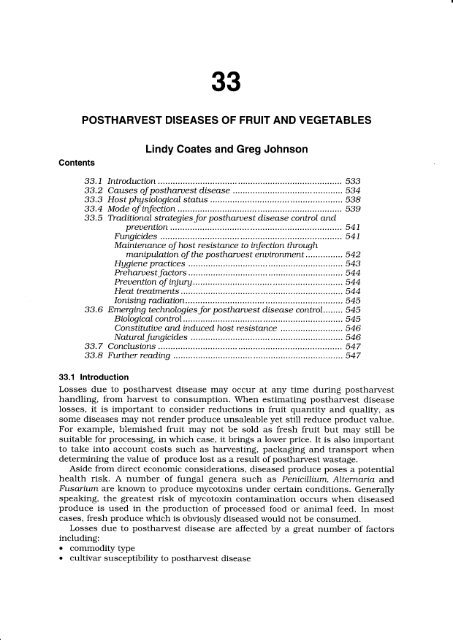
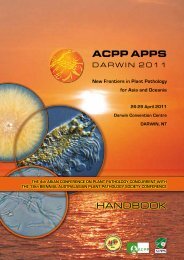
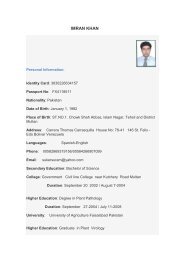

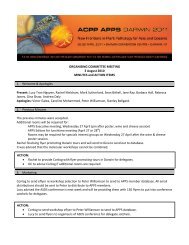
![[Compatibility Mode].pdf](https://img.yumpu.com/27318716/1/190x135/compatibility-modepdf.jpg?quality=85)
